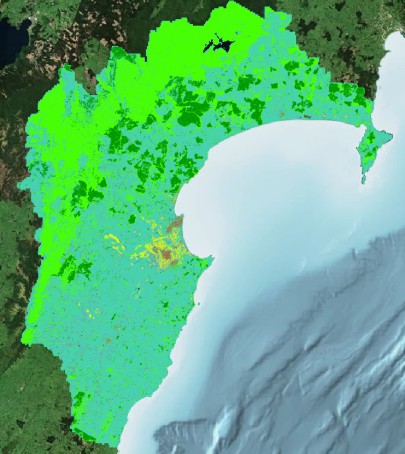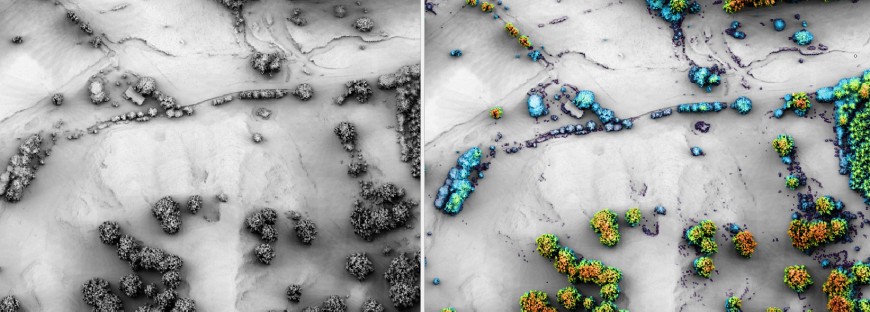
Overview and extent of region-wide vegetation layers for the Hawke’s Bay region depicting forest cover in bright green, low vegetation in pale green, fields in yellow and pine forest in dark green.
Manaaki Whenua programme lead Dr Sam Carrick says this initiative marks a significant step forward in helping the region manage land resources, address erosion, and improve environmental strategies.
The project, a result of a longstanding partnership with HBRC, leverages the power of LiDAR (Light Detection and Ranging) to produce high-resolution, regional maps of land and vegetation information.
Digital elevation models (DEMs) provide an unprecedented level of detail about the region’s topography, enabling more accurate assessments of erosion and sediment loads in rivers. Manaaki Whenua researcher Dr Hugh Smith says one key aspect of the project involved upgrading existing models with the new LiDAR data. “This update enhances the accuracy of predictions related to rainfall-triggered landslides, allowing for more targeted and effective tree planting initiatives. The high-resolution topographic data from LiDAR has also been integrated into the SedNetNZ model, which estimates erosion rates and suspended sediment loads in rivers.
“This model is crucial for evaluating various land management scenarios and understanding the impacts of climate change,” says Hugh.
The project’s success extends beyond scientific advancements with the collaboration between scientists and policymakers at HBRC fostering a deeper understanding of the practical applications of these models says HBRC senior land scientist Ashton Eaves. “By working together, both groups have developed tools and products that are immediately useful for the council’s decision-making processes.”
Another researcher in the Manaaki Whenua team, pedometrician Dr Nathan Odgers says one of the innovative applications of the new LiDAR data is in analysing the slope of the land. “Slope plays a critical role in water movement and erosion risk.
The detailed slope data, now available at five-metre intervals compared to the previous 25-metre intervals, enhances the accuracy of land use capability assessments and assists in implementing recent intensive winter grazing rules.”
The project also focused on producing high-resolution vegetation class layers and fine-scale canopy structure information. “We applied our state-of- the-art software workflows leveraging recent developments in computer vision and deep learning to process raw point cloud data and turned it into a comprehensive and detailed spatial catalogue of vegetation features comprising forests, shelter belts, exotic (pine) forests, fields, and individual trees. This layer also vastly surpasses the spatial detail of previous large- scale land cover products such as the Land Cover Database of New Zealand”, explains Manaaki Whenua researcher Dr Jan Schindler.

LiDAR images showing daylight and shadow images overlaid over canopy height layers.
The purpose of this work was not only to generate one-off data products, but to create baseline methods and data sets which can be updated and refined in the future and used for change detection.” Jan adds.
Former HBRC science manager, Anna Madarasz-Smith says the collaboration has proven mutually beneficial, allowing scientists and policymakers to develop practical solutions that directly address the region’s environmental challenges. “The partnership with Hawke’s Bay Regional Council highlights the importance of combining scientific expertise with local knowledge to achieve impactful results,” she says.

